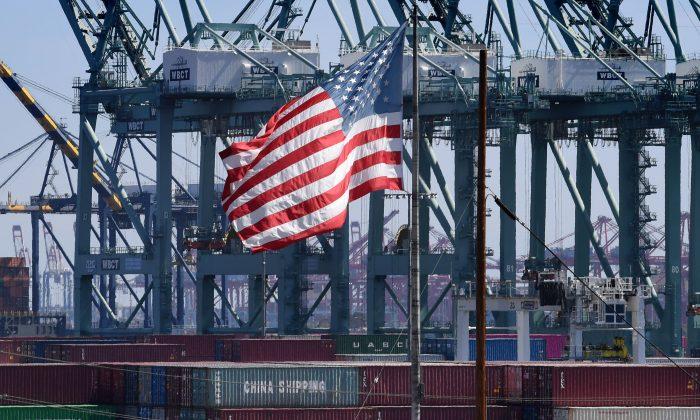News Analysis
U.S. ports led by the Port of Los Angeles, America’s busiest gateway for ocean trade with China, are expecting double-digit plunges for import traffic over the next few months. China’s ability to subsidize tariff cost for its companies may have come to an end due to a slowing economy and the Sino-U.S. trade.
China exports dropped by
3.2 percent in September compared to a year earlier, following a 1 percent drop in August, customs data showed.
China exporters have been accelerating container shipments of retail consumer goods to the U.S. West Coast ports since January in an effort to stay ahead of the Trump administration’s ratcheting-up of U.S. tariffs. But Port of LA container traffic fell by
2.9 percent in September to 402,320 twenty-foot equivalent units (TEU), its first decline in 2019.
Washington imposed a 15 percent tariff on more than
$125 billion in Chinese imports from Sept. 1. The tariff increases set for Oct. 15 were
suspended after both countries reached a partial trade deal during talks earlier this month. But if the trade negotiations break down, U.S. Treasury Secretary Steven
Mnuchin said a 15 percent tariff increase on $150 billion in Chinese goods could take effect on Dec. 15.
Shortly after the failed negotiations in September, the National Retail Federation’s Global Port Tracker
forecasted that import container traffic at major U.S. ports are set to plunge by 5.1 percent in October; 8.9 percent in November and a 9.3 percent in December.
President Donald Trump on Sep. 20
stated that after Chinese officials canceled a series of visits to U.S. farms in anticipation of a deal to buy huge amounts of American agricultural products, he still felt “no pressure” to cut a deal with China before the November 2020 elections.
Textbook economics would claim that the Trump administration’s $100 billion in tariffs on Chinese imports are a “
tax” on goods and services that will be collected by U.S. companies, but ultimately paid by U.S. consumers in the form of higher prices.
But in a real world there are multitudes of suppliers in over one hundred countries that compete on price. To maintain the tens of millions of export-related jobs that give the Chinese Communist Party (CCP) its credibility, the Chinese regime paid the $100 billion in tariffs by subsidizing state-owned enterprises and providing tax cuts to private companies.
As the Sino-U.S. trade war got underway in March 2018, China Premier Li Keqiang announced that the Chinese government would
cut annual income taxes by 800 billion yuan ($126 billion) “to help transform and upgrade the economy, as well as “activate the market and boost people’s creativity.”
As the Trump administration relentlessly upped the trade war tariffs, China took further steps in the first quarter of 2019 to stimulate its economy through government-sponsored
114.3 percent increase in fixed asset investment and slashed taxes and fees by another 2 trillion yuan ($298.3 billion).
U.S. shoe manufacturing employment has plunged since 1980 from
76,237 to 12,715. That number would be almost zero, except for the requirement that U.S. military boots be made in the United States. But despite footwear imported from China now being hit with 67 percent import duties, the Footwear Distributors and Retailers of America (FDRA)
reported that China’s share of footwear sold in the United States rose from 67 to 70 percent over the last eighteen months of the Sino-U.S. trade war.
Tax cuts and subsidies allowed China to maintain its export volumes, but The Epoch Times
reported on Sep. 3 that the International Monetary Fund officially warned Beijing that a combination of an aging population and falling tax revenues would cause China to suffer its first negative balance of payments in twenty-five years.
China held its annual consumer price index (CPI) inflation to just 2.5 percent for the first 8 months of 2019. But with the trade war raging and capital flight accelerating, China’s inflation rate jumped to 3 percent in September on an 11.2 percent increase in food inflation, the steepest inflation spike since the global financial crisis in 2008.
To maintain liquidity to pay for U.S. tariffs, China has sold $27.4 billion in U.S. Treasury bonds from February through August, according to the latest
U.S. Treasury report.
China’s State Council on Oct. 9 also issued a “
Five-Five Sharing” order that canceled the scheduled slashing of the local government’s allocation of China’s value-added-tax (VAT) from 50 percent to 25 percent. As China’s biggest tax source, the over $100 billion transfer from the central government dramatically increased the solvency of local governments at the expense of the central government.
Chriss Street is an expert in macroeconomics, technology, and national security. He has served as CEO of several companies and is an active writer with more than 1,500 publications. He also regularly provides strategy lectures to graduate students at top Southern California universities.






Friends Read Free